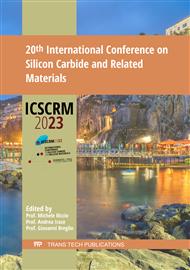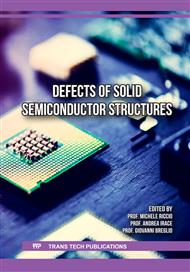p.87
p.93
p.99
p.105
p.111
p.117
p.123
p.129
p.135
Epitaxial Defectivity Characterization Combining Surface Voltage and Photoluminescence Mapping on 200mm 4H-SiC Wafers
Abstract:
Charge biased non-Contact Voltage imaging, QUAD (Quality Uniformity And Defects) is measured on epitaxial layers grown on 25 wafers of 200 [mm] 4H-SiC. Electrical data is analyzed and deviations in the ΔV signal are compared with defectivity observed by the optical surface detection system with UV-PL capability. Reliable statistical data of the relationship between decreasing voltage and defect classification show good detection of triangles and several other defects in the epitaxial layers. The QUAD mapping gives a good first indication of the electrical active defectivity of an epitaxial layer.
Info:
Periodical:
Pages:
111-115
Citation:
Online since:
August 2024
Keywords:
Permissions:
Share:
Citation:



